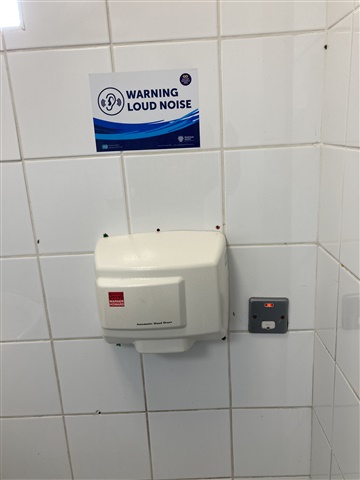Discussed at JPEL 64 high level committee meeting as a possible additional warning notice in case the noise from a hand dryer scares the life out of the user!

The warning notice is intended for autistic people. Whilst some people on the Spectrum may be intolerant of loud noises, there is no reason why it should be a surprise unless the particular person has never seen and used a hand drier before.
If the individual also has a learning disorder, he or she may not be able to read the notice.
I still think it's bonkers. It has nothing to do with electrical safety. There are loud noises etc everywhere that some people have to get used to. If they were that badly affected i doubt they would be unsupervised the first time they go in to a public toilet. ( Before anyone accuses me of being uncaring i have an autistic son so have first hand experience of some of the problems he encounters )
Gary
Do we suddenly have more people who are scared of noise than we did a decade or two ago ? Perhaps it is a feature of our fading industrial heritage, but to my mind there are plenty of noises a lot louder than a dryer in a toilet. (trains when they run, lorries airports, steelworks you name it.)
In any case I struggle to see how it is a JPEL matter - would they comment on labels for food mixers, electric drills etc ? No, surely that would be a product standard issue - along with recommending suitable PPE i safe sound levels were breached.
Mike.
Discussed at JPEL 64 high level committee meeting as a possible additional warning notice in case the noise from a hand dryer scares the life out of the user!
That warning notice wouldn't meet the requirements of Reg 514.9.2 and, if a workplace, the Health & Safety (Signs & Signals) Regulations.
The nearest relevant safety sign is ISO 7010 - W038 however, even if we accept that other symbols could be used (although I think this one might be confused with hearing loop signs), as a minimum a warning sign other than one provided on equipment according to the product standard must (legislation if in a workplace) [or shall (BS 7671 where that standard is used, but the legislation does not apply] be black on yellow triangle (with black border) with accompanying text usually black on yellow background:

Sorry Mike, I was being fictitious, just my silly attempt at trying to connect what I see as an over-zealous safety notice with the requirements of 7671.
Indeed. Further, this would be either a Health, Safety & Welfare issue, or a 'reasonable adjustment' according to other legislation.
HOWEVER, such a sign could be specified following an assessment according to PAS 6463:2022 Design for the mind. Neurodiversity and the built environment. Guide. (PAS 6463 is free to download: https://www.bsigroup.com/en-GB/standards/pas-6463/)
To be brutally honest, I am astonished at how immediately dismissive some comments in this thread are ... very similar to another thread in recent months where some posts which were tantamount to saying that people who miss spelling and grammar errors on reports and certification can't be competent. (In fact, this Victorian attitude helps me understand completely why some people with dyslexia etc. are reluctant to tell tutors on vocational courses about it before sitting exams!)
Regards neurodiversity, it is true that there are ever increasing rates of diagnosis. Whilst more is known by relevant professionals providing diagnosis, leading to increasing rates of diagnosis, it is also suspected that the actual underlying rate of cases is also increasing.
If they were that badly affected i doubt they would be unsupervised the first time they go in to a public toilet.
I agree, "coping strategies" are very important for some people with neurodiversity, and some individuals need other management approaches.
However, it's also the case that at the moment 15 % of the population in the UK are thought to be neurodiverse, and this is comparable with rates of hearing loss and visual impairment for people at pension age.
Given the fact that we have to make reasonable adjustments, I feel we ought to avoid, where practicable, making people's lives a misery, and if we can't, then we could help people prepare (with signage like this) if they have a strategy for managing the situation.
I welcome the publication of PAS 6463, and I would vote for it to be referenced in Approved Document M, Scotland Technical Handbooks, etc.
Regards neurodiversity, it is true that there are ever increasing rates of diagnosis. Whilst more is known by relevant professionals providing diagnosis, leading to increasing rates of diagnosis, it is also suspected that the actual underlying rate of cases is also increasing.
That is my impression, not least because I have a professional interest in the matter. The quality of diagnosis is variable.
However, my view of autistic people is that they are capable, it's just that they think differently.
What about the systematising quotient? Might that be a benefit in engineering?
We're about to take you to the IET registration website. Don't worry though, you'll be sent straight back to the community after completing the registration.
Continue to the IET registration site